Abstract
OBJECTIVE--The aim was to study the association between personal factors and physical and psychosocial work environment factors and disorders of the neck or upper limbs among women in the fish processing industry. METHODS--A cross sectional study was performed on 206 women in the fish processing industry and 208 control women. Several physical and psychosocial work environment factors were evaluated. Subjective complaints about the neck or upper limbs were assessed by questionnaire and by a clinical examination. RESULTS--The study showed a high prevalence (35%) of diagnoses in the neck or shoulders of the exposed women. All prevalence odds ratios (POR's) were substantially higher in young women. There was a pronounced dose-response relation between disorders of the neck or shoulders and duration of employment for women < 45 years old. When studying 322 former workers, the proportion who claimed musculoskeletal complaints as the reason for leaving was highest among the older women. Muscular tension, stress or worry, work strain, and the largest fraction of the work time spent with highly repetitive work tasks were clearly associated with disorders of the neck or shoulders. The measurements of the wrist movements also showed that the work was performed almost without any pauses and that the median flexion and extension velocity was high (41 degree/s). The results of observation showed good agreement with the measurements of wrist motion. CONCLUSION--Work in the fish processing industry is a risk factor for disorders of the neck and upper limbs. Due to the homogenity of the physical work load in the exposed group, we could not show any associations between the objective measurements and disorders. In cross sectional studies the risk may be underestimated due to a healthy worker effect.
Full text
PDF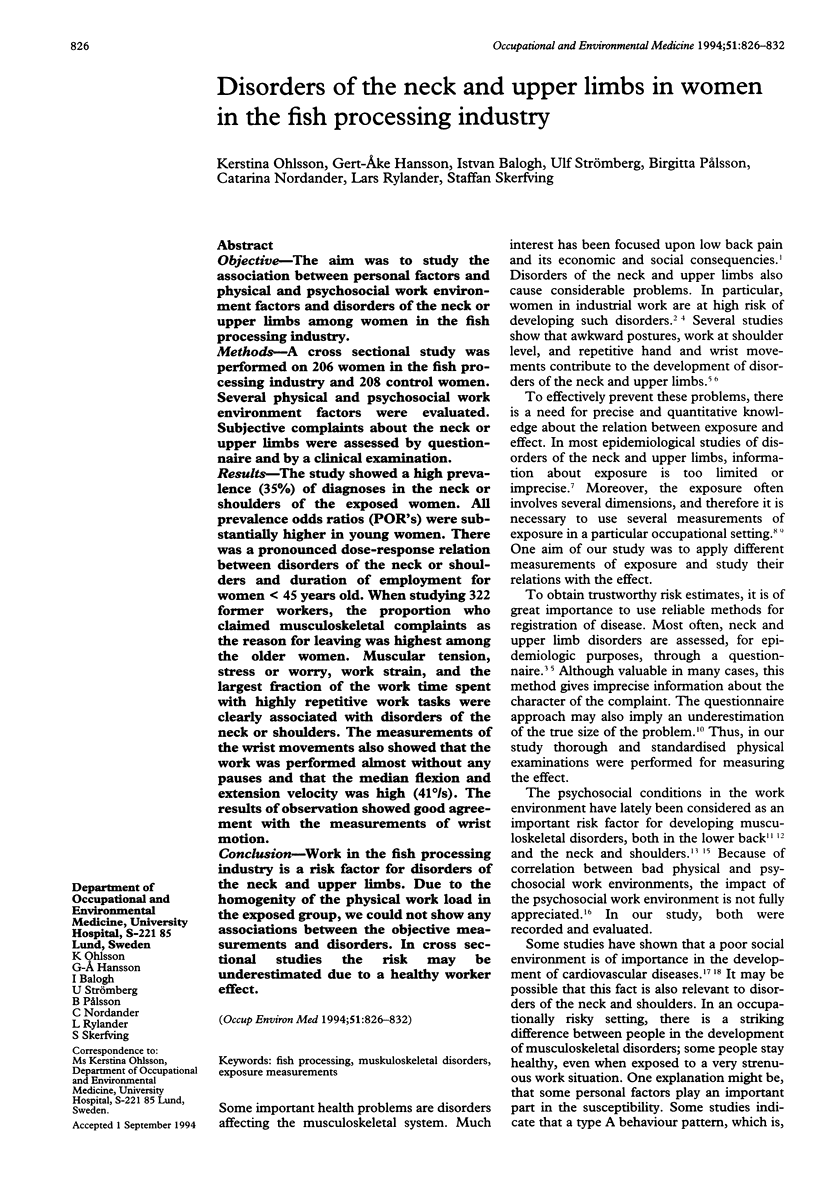
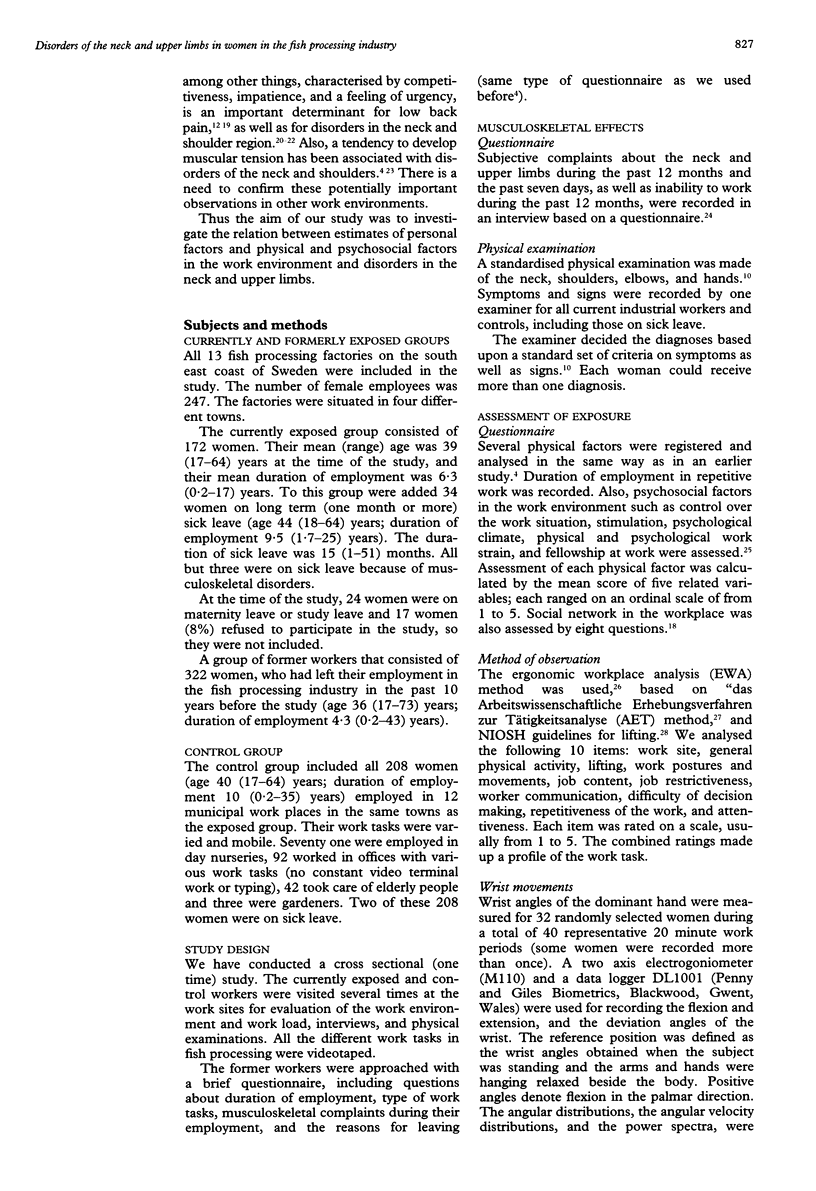
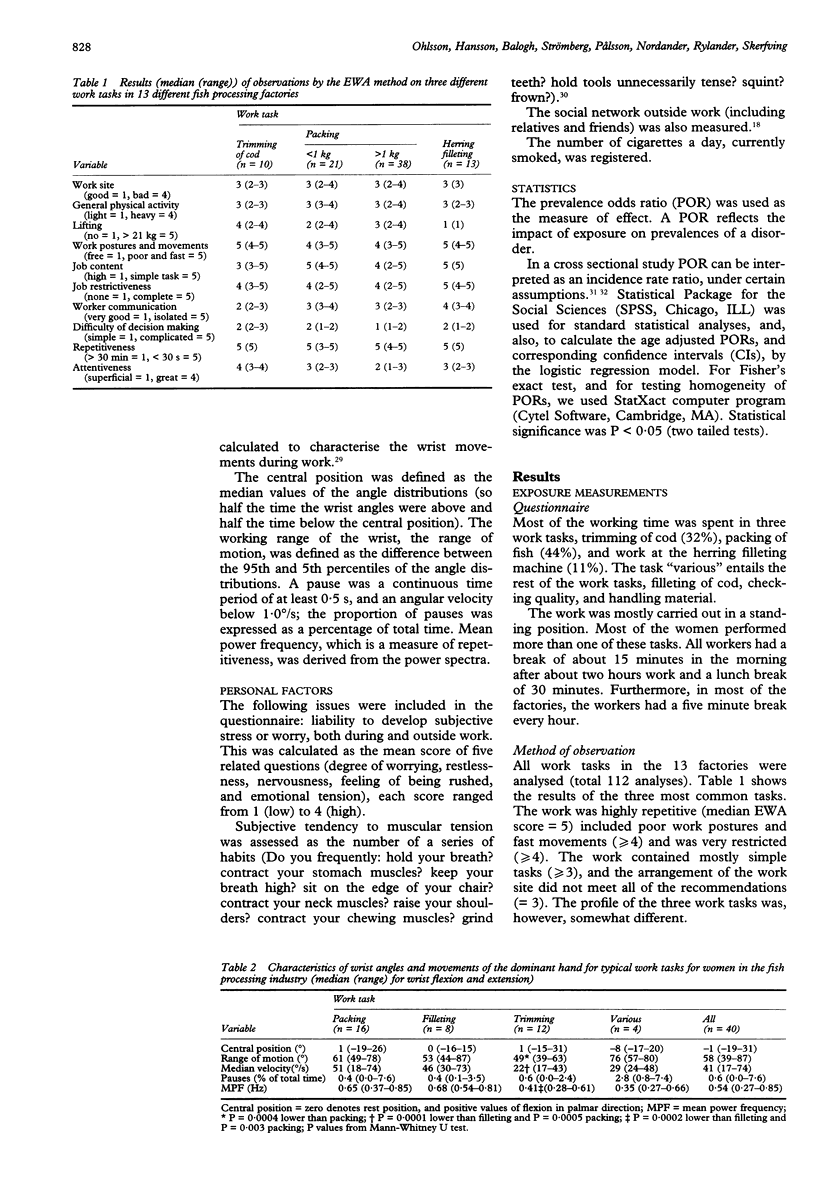
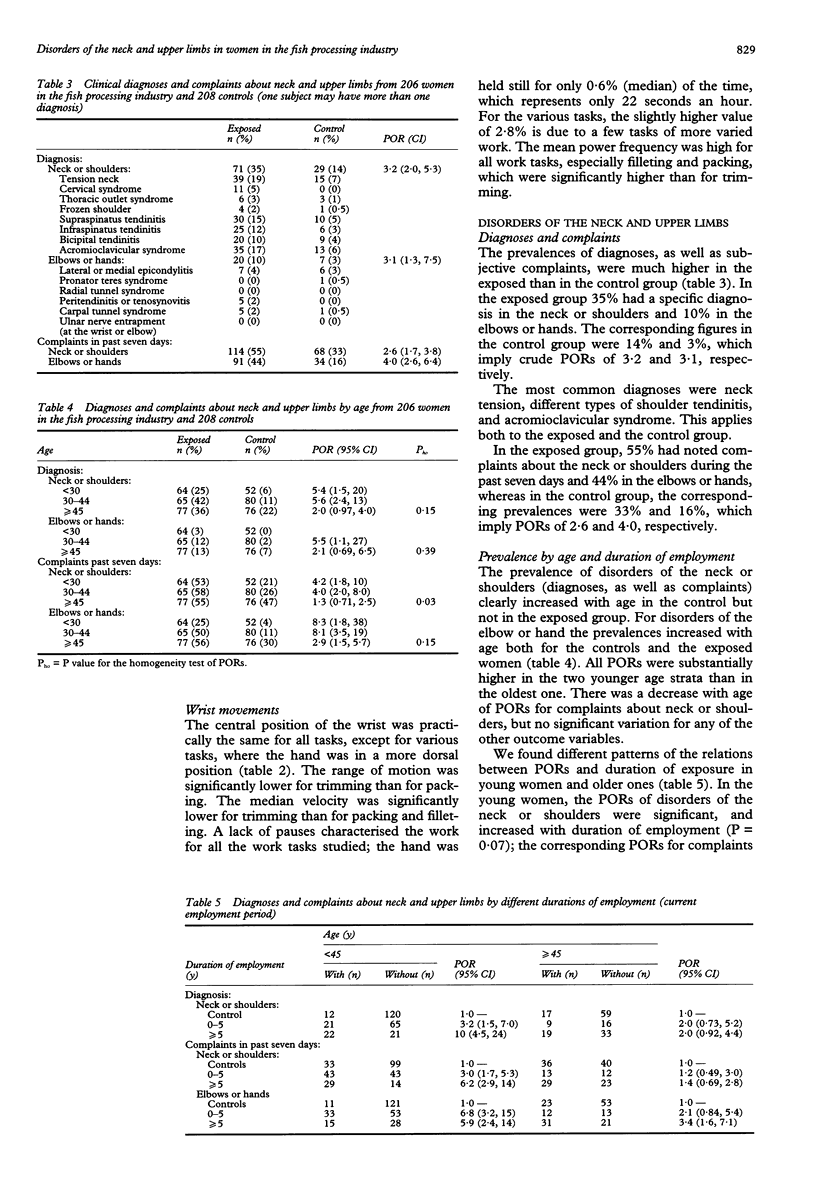
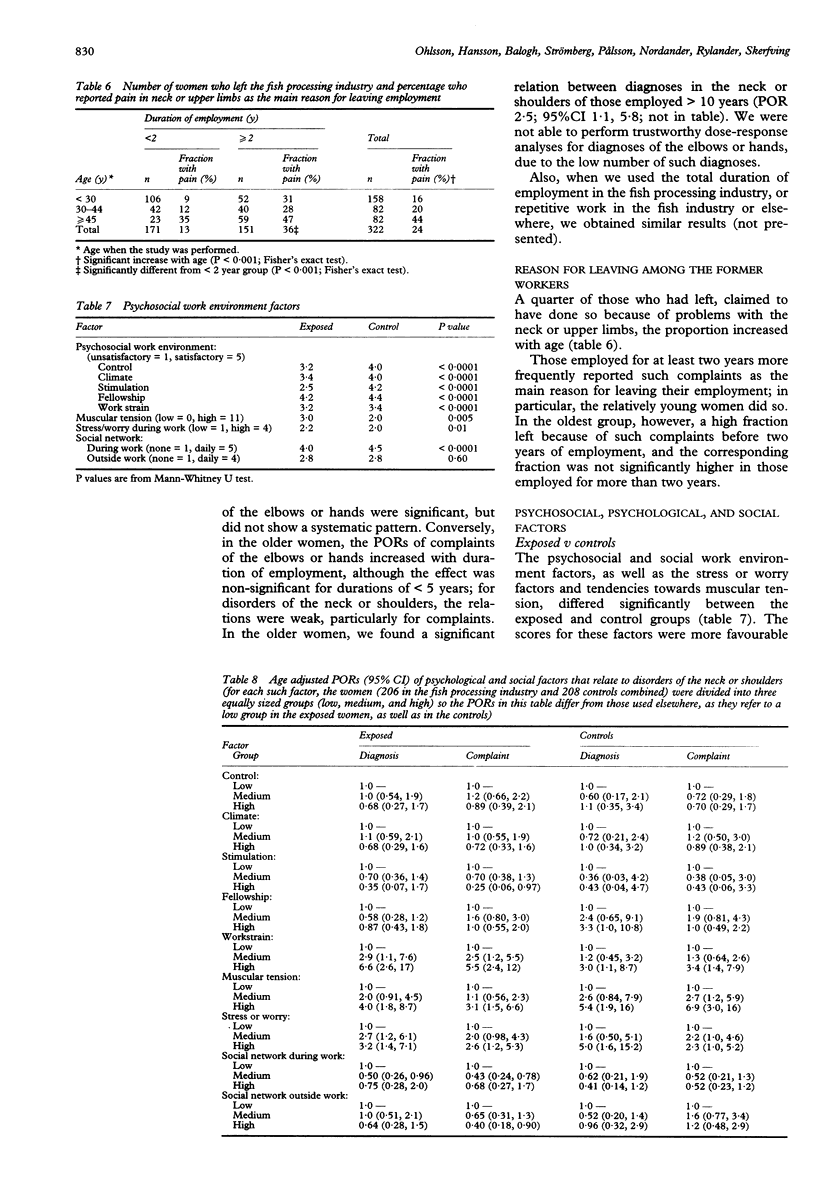
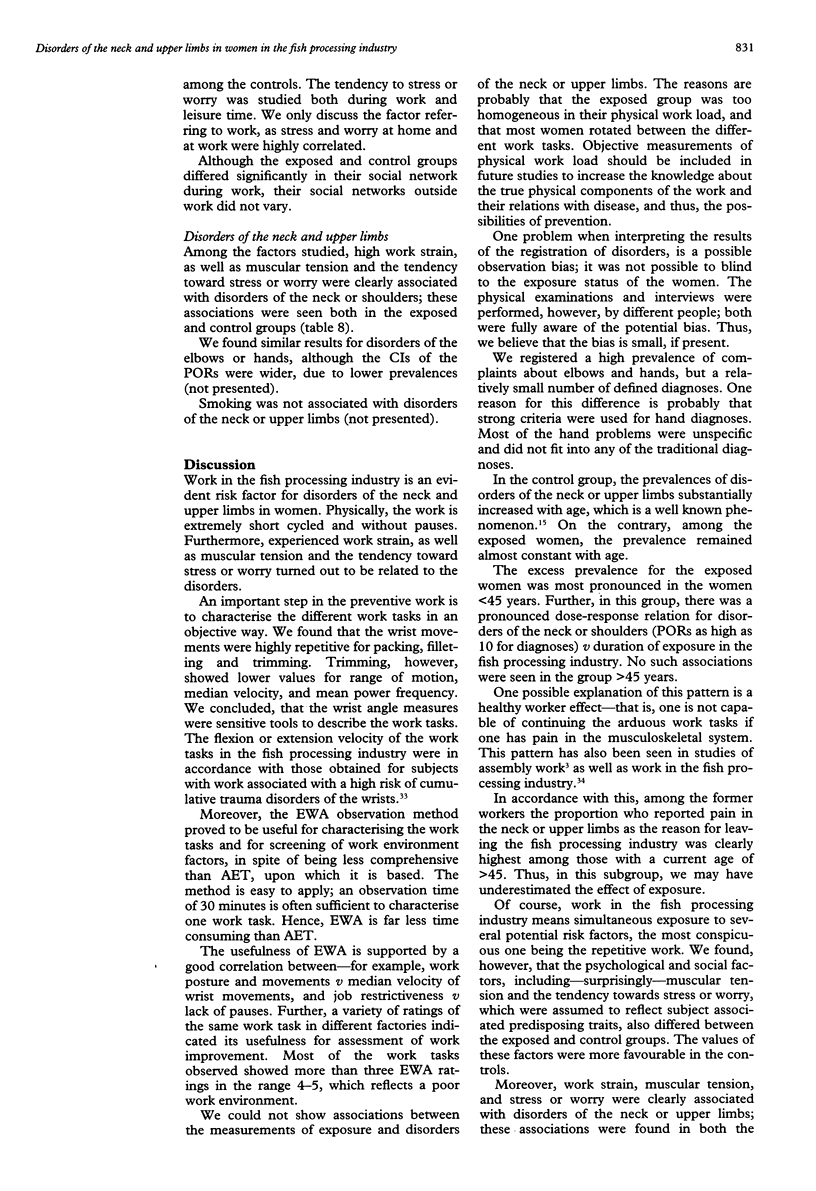
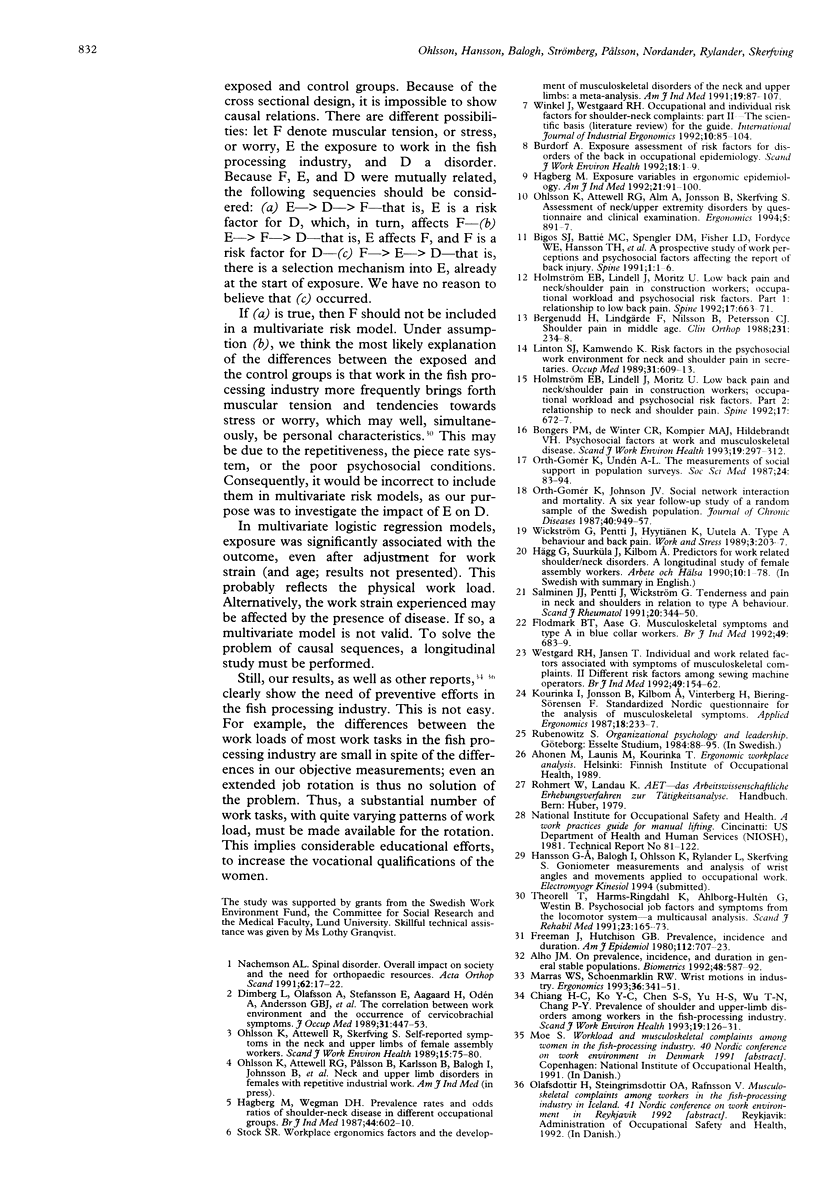
Selected References
These references are in PubMed. This may not be the complete list of references from this article.
- Alho J. M. On prevalence, incidence, and duration in general stable populations. Biometrics. 1992 Jun;48(2):587–592. [PubMed] [Google Scholar]
- Bergenudd H., Lindgärde F., Nilsson B., Petersson C. J. Shoulder pain in middle age. A study of prevalence and relation to occupational work load and psychosocial factors. Clin Orthop Relat Res. 1988 Jun;(231):234–238. [PubMed] [Google Scholar]
- Bigos S. J., Battié M. C., Spengler D. M., Fisher L. D., Fordyce W. E., Hansson T. H., Nachemson A. L., Wortley M. D. A prospective study of work perceptions and psychosocial factors affecting the report of back injury. Spine (Phila Pa 1976) 1991 Jan;16(1):1–6. doi: 10.1097/00007632-199101000-00001. [DOI] [PubMed] [Google Scholar]
- Bongers P. M., de Winter C. R., Kompier M. A., Hildebrandt V. H. Psychosocial factors at work and musculoskeletal disease. Scand J Work Environ Health. 1993 Oct;19(5):297–312. doi: 10.5271/sjweh.1470. [DOI] [PubMed] [Google Scholar]
- Chiang H. C., Ko Y. C., Chen S. S., Yu H. S., Wu T. N., Chang P. Y. Prevalence of shoulder and upper-limb disorders among workers in the fish-processing industry. Scand J Work Environ Health. 1993 Apr;19(2):126–131. doi: 10.5271/sjweh.1496. [DOI] [PubMed] [Google Scholar]
- Dimberg L., Olafsson A., Stefansson E., Aagaard H., Odén A., Andersson G. B., Hansson T., Hagert C. G. The correlation between work environment and the occurrence of cervicobrachial symptoms. J Occup Med. 1989 May;31(5):447–453. [PubMed] [Google Scholar]
- Flodmark B. T., Aase G. Musculoskeletal symptoms and type A behaviour in blue collar workers. Br J Ind Med. 1992 Oct;49(10):683–687. doi: 10.1136/oem.49.10.683. [DOI] [PMC free article] [PubMed] [Google Scholar]
- Freeman J., Hutchison G. B. Prevalence, incidence and duration. Am J Epidemiol. 1980 Nov;112(5):707–723. doi: 10.1093/oxfordjournals.aje.a113043. [DOI] [PubMed] [Google Scholar]
- Hagberg M. Exposure variables in ergonomic epidemiology. Am J Ind Med. 1992;21(1):91–100. doi: 10.1002/ajim.4700210111. [DOI] [PubMed] [Google Scholar]
- Holmström E. B., Lindell J., Moritz U. Low back and neck/shoulder pain in construction workers: occupational workload and psychosocial risk factors. Part 1: Relationship to low back pain. Spine (Phila Pa 1976) 1992 Jun;17(6):663–671. doi: 10.1097/00007632-199206000-00005. [DOI] [PubMed] [Google Scholar]
- Holmström E. B., Lindell J., Moritz U. Low back and neck/shoulder pain in construction workers: occupational workload and psychosocial risk factors. Part 2: Relationship to neck and shoulder pain. Spine (Phila Pa 1976) 1992 Jun;17(6):672–677. doi: 10.1097/00007632-199206000-00006. [DOI] [PubMed] [Google Scholar]
- Kuorinka I., Jonsson B., Kilbom A., Vinterberg H., Biering-Sørensen F., Andersson G., Jørgensen K. Standardised Nordic questionnaires for the analysis of musculoskeletal symptoms. Appl Ergon. 1987 Sep;18(3):233–237. doi: 10.1016/0003-6870(87)90010-x. [DOI] [PubMed] [Google Scholar]
- Linton S. J., Kamwendo K. Risk factors in the psychosocial work environment for neck and shoulder pain in secretaries. J Occup Med. 1989 Jul;31(7):609–613. doi: 10.1097/00043764-198907000-00012. [DOI] [PubMed] [Google Scholar]
- Marras W. S., Schoenmarklin R. W. Wrist motions in industry. Ergonomics. 1993 Apr;36(4):341–351. doi: 10.1080/00140139308967891. [DOI] [PubMed] [Google Scholar]
- Nachemson A. L. Spinal disorders. Overall impact on society and the need for orthopedic resources. Acta Orthop Scand Suppl. 1991;241:17–22. [PubMed] [Google Scholar]
- Ohlsson K., Attewell R. G., Johnsson B., Ahlm A., Skerfving S. An assessment of neck and upper extremity disorders by questionnaire and clinical examination. Ergonomics. 1994 May;37(5):891–897. doi: 10.1080/00140139408963698. [DOI] [PubMed] [Google Scholar]
- Ohlsson K., Attewell R., Skerfving S. Self-reported symptoms in the neck and upper limbs of female assembly workers. Impact of length of employment, work pace, and selection. Scand J Work Environ Health. 1989 Feb;15(1):75–80. doi: 10.5271/sjweh.1879. [DOI] [PubMed] [Google Scholar]
- Orth-Gomér K., Johnson J. V. Social network interaction and mortality. A six year follow-up study of a random sample of the Swedish population. J Chronic Dis. 1987;40(10):949–957. doi: 10.1016/0021-9681(87)90145-7. [DOI] [PubMed] [Google Scholar]
- Orth-Gomér K., Undén A. L. The measurement of social support in population surveys. Soc Sci Med. 1987;24(1):83–94. doi: 10.1016/0277-9536(87)90142-0. [DOI] [PubMed] [Google Scholar]
- Salminen J. J., Pentti J., Wickström G. Tenderness and pain in neck and shoulders in relation to Type A behaviour. Scand J Rheumatol. 1991;20(5):344–350. doi: 10.3109/03009749109096810. [DOI] [PubMed] [Google Scholar]
- Stock S. R. Workplace ergonomic factors and the development of musculoskeletal disorders of the neck and upper limbs: a meta-analysis. Am J Ind Med. 1991;19(1):87–107. doi: 10.1002/ajim.4700190111. [DOI] [PubMed] [Google Scholar]
- Theorell T., Harms-Ringdahl K., Ahlberg-Hultén G., Westin B. Psychosocial job factors and symptoms from the locomotor system--a multicausal analysis. Scand J Rehabil Med. 1991;23(3):165–173. [PubMed] [Google Scholar]
- Westgaard R. H., Jansen T. Individual and work related factors associated with symptoms of musculoskeletal complaints. II. Different risk factors among sewing machine operators. Br J Ind Med. 1992 Mar;49(3):154–162. doi: 10.1136/oem.49.3.154. [DOI] [PMC free article] [PubMed] [Google Scholar]


